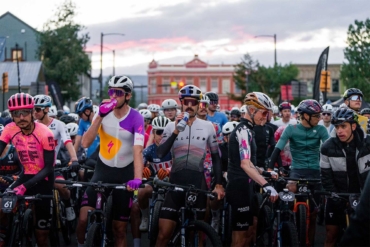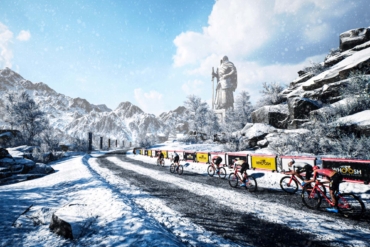Close your eyes, take a deep breath, and imagine this: a mountain bike that rolls over big rocks like a monster truck, stomps landings like a pro, and still feels snappy and playful in tight, technical sections.
If you think a bike that’s both nimble and formidable sounds like a unicorn, I promise you it’s not. This is a mixed-wheeled bike, better known as the “mullet bike.” And I’m here to convince you it offers the best of both worlds.
Business in the front, party in the back, mullets typically have a 29er wheel in front and 27.5 in the rear, playing on the strengths of each. Like the haircut, they value practicality over aesthetics, hitting the sweet spot between the two and ending the tired debate about which wheel size is better.
Without spilling unnecessary ink, both 29ers and 27.5-inch mountain bikes have their merits and shortcomings. Mullet bikes, on the other hand, are just freaking fun to ride. They provide stability and capability — and they punch through rock gardens with ease. At the same time, they retain maneuverable, tight handling.
Generally speaking, mullets are also slacker and accelerate faster. The only glaring downside is issues on rocky climbs, which we’ll get into a bit later. Read on for all you’d ever want to know about the mighty mullet (bike).

Mullet Bike: Quick History Lesson
The first commercial mullet bike, the Big Hit, was launched by Specialized in 2004 with a 24-inch rear wheel and 26-inch front. Unfortunately, the Big Hit was actually not a big hit with consumers.
An unbalanced geometry, heavy frame, and lackluster marketing led the brand to discontinue the bike a few years later. In 2009, Trek took a swing at the mullet category with the 69er, which had a 26-inch rear wheel and 29-inch front. The bike showed promise but ultimately didn’t survive.
However, the idea still prevailed with a handful of small bikemakers and enthusiasts who fabricated their own franken-bikes. In the last 2 years, mullets have made a rapid resurgence, starting with the downhill race world.
When the UCI relaxed its restrictions on mixed-wheel bikes in competitions in January 2019, many elite riders began using mullets and taking podiums, creating a buzz around the bike world.
Who Makes Mullet Bikes?
Still a small share of the mountain bike market, mullets are on the rise. Some examples include the MDE Damper, Alchemy Arktos, Foes Mixer, Starling Cycles Twist, Liteville 301 MK15, Canyon Sender CFR, Kona Process X, and the Specialized Status (the first fully dedicated mullet from a major brand).
“When you hop on a mullet, you notice the difference right away — a big difference. They are a great option, but it depends on the trail you ride,” Steve Saletnik, product manager for the Status and admitted mixed-wheel advocate, told us. “They aren’t a silver bullet but certainly have a place at the table.”

Mixed-Wheel Mullet Bike: Pros & Cons
The advantages of mullets are numerous. First, they offer more control in rocky terrain. A bigger wheel will hang up less, and the steering is more controlled.
Second, they offer more rear clearance, which is a common problem on steep trails and going over steep drops. Third, they take the inside line by helping improve tight cornering.
Fourth, slacker geo will reduce rolling resistance and speed you up. And last, maybe you just want something new. Curiosity is rarely a bad thing.
Yet, there’s always a downside. Mullet bikes are often imbalanced if not tuned correctly.
“It’s not as simple as swapping out the rear wheel — that can have huge, negative consequences and can ruin your bike,” Saletnik said.
Instead, he suggests getting one that has a geometry designed specifically for mixed wheel sizes. If you don’t, it’s easy to feel behind the wheel and not at the center of the bike, making climbing harder, especially on rocky, steep, or technical trails.
Mullet Bikes: Who Are They For?
Anyone who feels outgunned on a 27.5-inch bike or lacking maneuverability on a full 29er should consider a mullet. So much of mountain biking is about confidence, which mullets provide in multiple ways.
You can see the big wheel out in front, taking care of business on large rocks and rough transitions. Yet you also feel snappy in tight corners and berms, with a more nimble bike. Plus, with a slacker geometry, you feel more comfortable laying off the brakes and just letting the bike work.
“Mullets provide versatility between the two wheel sizes,” Saletnik told us. “They’re really fun to session, play on jumps, and handle most trails well. A mixed-wheel bike does more things well than other options. Also, smaller riders get more body clearance, which is especially important for downhill bikes.”
“Oh,” he added, “and they’re easy to manual.”








